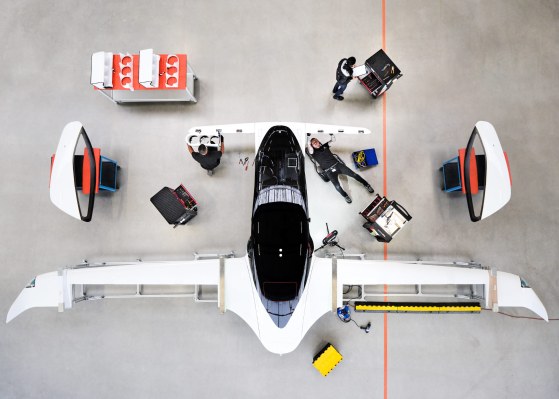Lilium, the Munich-based startup developing an on-demand “air taxi” service, has released its latest flight video — this time demonstrating a successful transition from vertical flight (liftoff) to horizontal flight.
The company is also announcing the completion of its first manufacturing facility and plans for a much larger second factory in preparation for a 2025 commercial launch.
In the flight footage (embedded below), the five-seater all-electric Lilium Jet can be seen taking off and then transitioning to horizontal flight, where it functions along broadly similar lines to a conventional airplane.
Describing this type of transition as one of “aerospace’s greatest challenges,” Lilium claims it gives the Lilium Jet a range advantage over some other competitors, with its two sets of wings contributing to much higher levels of efficiency than in aircraft lifted solely by rotors.
“Powered by 36 all-electric jet engines, the aircraft has zero operating emissions and requires less than 10% of its maximum 2000 horsepower during horizontal cruise flight thanks to the lift generated by having two sets of wings,” explains Lilium.
The company — which we reported is currently raising a large round of funding, thought to be between $400 million and $500 million — is also disclosing that its jet has now been flown at speeds exceeding 100 km/h and undergone “increasingly complex” maneuvers. It says it is still on track to be able to complete journeys of up to 300 kilometre in one hour and on a single charge.
In a call with Remo Gerber, Lilium’s chief commercial officer (CCO), he reiterated the company’s plans for a “meaningful” 2025 launch and talked up the 300 kilometre target range. Specifically, he explained that this means Lilium will be able to operate an air taxi service that connects cities and country regions, rather than simply speeding up travel time across a single city.
“We’re actually quite clear in our mind what our goal is,” Gerber told me when asked to elaborate on Lilium’s 2025 ambitions. “We want to be live and a real, meaningful part of transportation ecosystems in several cities around the world. So what does that mean? We’re having talks around the world with a number of different cities and governments and then entire regions to look at how we best connect them.”
Describing England in the U.K. as one example of an ecosystem, where the main hubs are reachable within a 300 kilometre range, he says we could imagine services between London-Manchester, Manchester-Birmingham, Birmingham-London, “or maybe down to Brighton and several other places.”
“So that is really a meaningful new addition to transportation opportunities for customers and for people to use every day,” says Gerber. “And that wouldn’t be just something that will be useful for Londoners, but it would be just as useful for people living in the other larger towns but also — and that’s where the timeline is [hard to predict] — how quickly other smaller cities jump on the opportunity.”
The upside for building the landing pads, which will need to be close to other transport links, is that it will require a “manageable investment” compared to much larger and more capital intensive infrastructure projects. The smallest and most affordable sizes of a pad will cost as little as half a million pounds to build, says Gerber.
“I can all of a sudden make one investment into a pad the size of a football field and be connected to all of these other 10 different pads in the country. And that’s where we’re coming in,” he explains, revealing that Lilium is already having conversations with various different parties who are interested in creating a landing site.
“We are developing the blueprints for people and we will be advising people what they need to build. Of course, we cannot go and build all around the world all of these landing sites, but where we will come in is to work with these cities to say ‘how do we connect you in a meaningful way into the network, into the Lilium service.’ That’s how you have to imagine it.”
It won’t all be tax payer-funded or public money, but private companies will also be courted. These could be shopping malls that want additional footfall or large businesses that want their business parks to be connected in different ways or want a 10-minute transfer to a specific airport.
However, Gerber says Lilium will remain “ultra-cautious” with regards to where Lilium landing pads are created so there is “no negative impact” on communities.
“We see the landing infrastructure to a very large extent is the public good,” he tells me. “We see it a bit like on the scale of a train station, because it should have a use to the community that it serves and that’s where really our whole philosophy comes in.”
Meanwhile, Lilium’s first manufacturing facility is a 3,000-square-meter space located at the company’s headquarters in Southern Germany. It will soon be complemented by a second, much larger, facility which is already under construction at the same site. The plan is to be capable of producing hundreds of Lilium aircraft per year by the time commercial services begin in 2025.
“There’s a tremendous opportunity when you have the manufacturing sitting next to the engineers because they can work together,” says Gerber. “Now we know the performance is right, how do we tweak it so that it’s actually also easy to make, so that we can get that scale? We’re building the first manufacturing line to really produce this aircraft at scale.”
